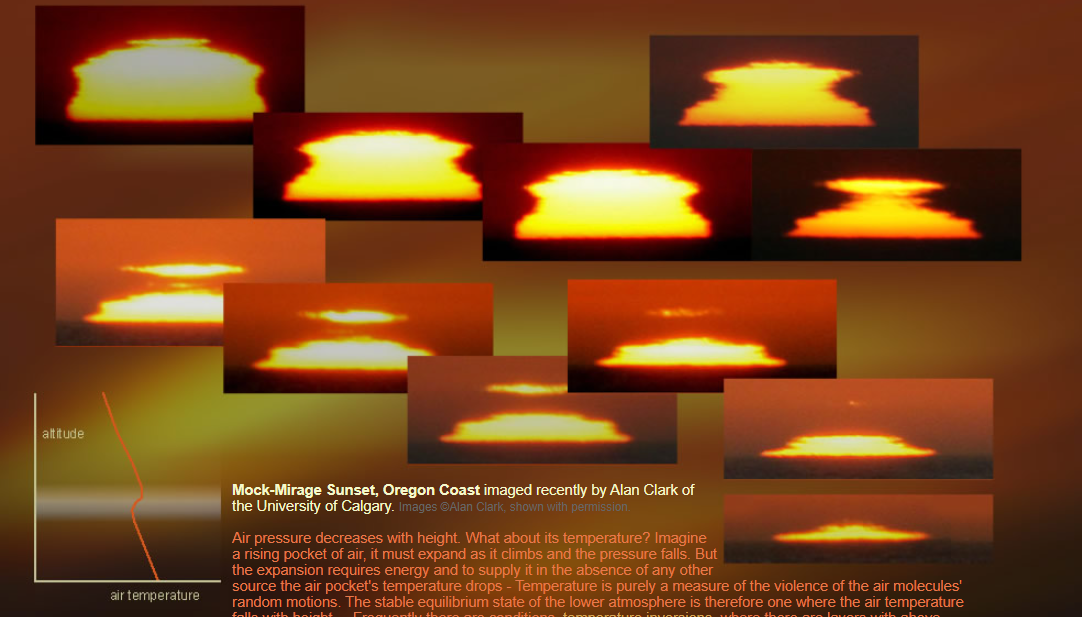Mock-Mirage Sunset
Mock-Mirage Sunset: A Phenomenon of Atmospheric Optics
When it comes to atmospheric optics, there are fascinating phenomena that can captivate our imagination. One such phenomenon is the mock-mirage sunset. Recently, Alan Clark of the University of Calgary captured stunning images of a mock-mirage sunset along the Oregon Coast. These images, with permission from Alan Clark, showcase the mesmerizing beauty of this atmospheric occurrence.
To understand the mock-mirage sunset, we must first explore the relationship between air pressure and temperature. As air rises, its pressure decreases, causing it to expand. This expansion requires energy, and in the absence of any external source, the temperature of the air pocket drops. Temperature, in this context, is a measure of the random motions of air molecules. Therefore, in the stable equilibrium state of the lower atmosphere, we observe a decrease in air temperature with height.
However, there are instances when temperature inversions occur, leading to layers with above equilibrium temperatures. These temperature inversions create ideal conditions for the formation of mock-mirages during sunsets.
During a mock-mirage sunset, the rays of the setting sun slant through the inversion layers and are refracted and curved to an extent that they form a mock-mirage. This refraction and curvature cause the sun to appear as if it is cut into at least three slices, some descending and others ascending. The result is a breathtaking display of light and color.
In addition to the mesmerizing visual effect of a mock-mirage sunset, these conditions are also favorable for the occurrence of green flashes. Green flashes are optical phenomena where a green spot is momentarily visible just above the upper rim of the setting or rising sun. However, in the case of the Oregon Coast mock-mirage sunset, the presence of sea mist masked the potential green flashes that could have been observed.
It's important to note that the mock-mirage sunset is a result of specific atmospheric conditions. The temperature and air density differences need to be strong enough to create the necessary refraction and curvature of light. These conditions, coupled with temperature inversions, create a unique visual spectacle that leaves us in awe of the wonders of the atmosphere.
While the mock-mirage sunset is a captivating phenomenon, it's worth mentioning that it is just one example of the many atmospheric optics phenomena that exist. From rainbows to halos, our atmosphere never ceases to amaze us with its ability to bend and scatter light, creating stunning displays in the sky.
In conclusion, the mock-mirage sunset is a breathtaking display of atmospheric optics. It occurs when temperature inversions create layers with above equilibrium temperatures, allowing the rays of the setting sun to be refracted and curved, forming a mock-mirage. The resulting visual effect is a sun that appears cut into multiple slices. Although sea mist may have masked the potential green flashes during the Oregon Coast mock-mirage sunset, the conditions were still ideal for their occurrence. This phenomenon reminds us of the beauty and complexity of our atmosphere and its ability to create awe-inspiring spectacles for us to admire.

Mock-Mirage Sunset, Oregon Coast imaged recently by Alan Clark of the University of Calgary. Images ©Alan Clark, shown with permission.
Air pressure decreases with height. What about its temperature? Imagine a rising pocket of air, it must expand as it climbs and the pressure falls. But the expansion requires energy and to supply it in the absence of any other source the air pocket's temperature drops - Temperature is purely a measure of the violence of the air molecules' random motions. The stable equilibrium state of the lower atmosphere is therefore one where the air temperature falls with height. Frequently there are conditions, temperature inversions, where there are layers with above equilibrium temperatures. When the temperature and air density differences are strong enough the rays of the setting sun slanting through the inversion are refracted and curved sufficiently to form a mock-mirage. The sun appears cut into at least three slices, some descending and others descending. These are ideal conditions for mock-mirage green flashes and they were probably occurring here but were masked by sea mist.
Note: this article has been automatically converted from the old site and may not appear as intended. You can find the original article here.
Reference Atmospheric Optics
If you use any of the definitions, information, or data presented on Atmospheric Optics, please copy the link or reference below to properly credit us as the reference source. Thank you!
-
<a href="https://atoptics.co.uk/blog/mock-mirage-sunset/">Mock-Mirage Sunset</a>
-
"Mock-Mirage Sunset". Atmospheric Optics. Accessed on April 24, 2024. https://atoptics.co.uk/blog/mock-mirage-sunset/.
-
"Mock-Mirage Sunset". Atmospheric Optics, https://atoptics.co.uk/blog/mock-mirage-sunset/. Accessed 24 April, 2024
-
Mock-Mirage Sunset. Atmospheric Optics. Retrieved from https://atoptics.co.uk/blog/mock-mirage-sunset/.